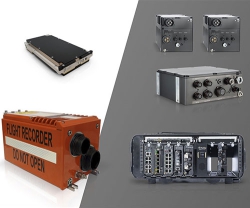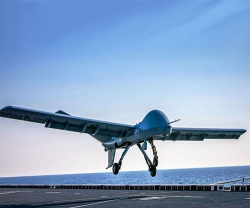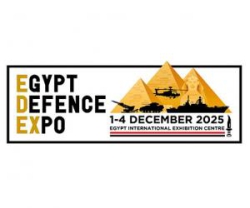Leonardo displayed a suite of its main technologies during the first sea demonstration of OCEAN2020, the first project financed by the European Union and managed by EDA in the framework of PADR (Preparatory Action on Defence Research).
The Italian company heads a team of 42 partners coming from 15 European countries, including industries, research institutes and the Defence Ministry of Greece, Spain, Portugal and Lithuania. In details, the project includes two massive naval demonstrations: the first one took place in the Gulf of Taranto on the 20 and 21st of November 2019, the second will take place in 2020 in the Baltic Sea.
Five ships, nine piloting remote systems, five satellites, two ground communication networks, four national coordination centres (Maritime Operations Centre - MOC) and the prototype of a European operational centre based in Brussels: these key assets were employed during the two days of the first sea demo to analyse how remote piloting systems can contribute to maritime surveillance, leveraging on integration and interoperability capabilities.
Led by the Italian Navy, the demonstration ran a scenario based on the interdiction of a threatening vessel: and one based on the interception of a mine-laying vessel before an amphibious operation.
Specifically the following assets took part in the sea demo frigate Martinengo (Italy), frigate Fasan (Italy), frigate Santa Maria (Spain), frigate Limnos (Greece) and refuelling vessel VAR (France); 9 unmanned systems UAS SW-4 Solo (Leonardo), UAS AW Hero (Leonardo), OPAS BK180-ISP (Blackshape), UAS Pelicano (Indra), USS SEAD-23 (Seadrone), USS SeaRider (Intracom Defence Electronic), USS Inspector (ECA Robotics), ROV Seascan (ECA Robotics), e l’AUV A9 (ECA Robotics); four Maritime Operational Centres: in Rome, Athens, Cartaghena (Spain), and Lisbon, and the prototype of the EU-MOC in Brussels, with five satellite systems COSMO-SkyMed, ATHENA FIDUS, HELLAS, SYRACUSE and INMARSAT.
Among the leading technologies deployed in the Gulf of Taranto, Leonardo contributed with two unmanned systems, AWHERO (photo) and SW-4 Solo, both rotary wing, together with the TSDT (Tactical Situation Digital Table).
The AWHERO accomplished all its four planned missions on board the Italian Navy’s FREMM Virginio Fasan, including automatic take-off and landing procedures from the vessels’ bridge. AWHERO, equipped with EO/IR and AIS 10’’ sensors, successfully detected, identified and tracked the intruder vessel.
Footage and real time data were sent from the vessel, thanks to the integration with the naval CMS (Combat Managent System), to the MOCs through the satellite communication infrastructure. During the demo AWHERO teamed-up with other unmanned assets (among which the Leonardo SW-4 Solo OPV) with multi-source data integration.
Moreover, in the second scenario, manned/unmanned team activities were involved to deliver real time data to a NH90 helicopter and to a small vessel during the attack to a hostile vessel.
SW-4 is a rotary wing unmanned system with a maximum load factor in take off of 1800 kg, capable of 5 hour flights with 100 kg payload Used in several ground and sea demos, it displayed company’s knowledge in unmanned technology.
During operations, the helicopter was equipped with an Osprey 30 radar, manufactured by Leonardo, and with a 15’’ ElectroOptical/Infrared Camera, Goshawk II di Hensold, partner of the consortium. The system was integrated with the CMS of the FREMM F. Martinengo and controlled by a station on the vessel, and carried out all the 4 planned missions.
The mission included detection, identification and recognition of the suspect vessel. The radar was activated for detection and identification, while the EO/EI camera was used for identification and autotracking.
Moreover, SW-4 supported Special Forces during boarding operations on the suspect vessel, sharing data with the portable mission stations, installed temporarily on the vessel (RHIB) and on the NH90 helicopter.
The activities during the sea demonstration also included the integration of data collected from the assets employed in the operational theatre in order to develop a Recognized Maritime Picture (RMP). In this field, the TSDT “Tactical Situation Digital Table, covered the task of tactical monitoring and coordination centre for an effective deployment of unmanned vehicles.
Four coordination units were interconnected and equipped with computers, workstation, and multimedia displays:
- Combat Information Centre (CIC) of the flagship vessel (frigate MARTINENGO)
- Combat Information Centre (CIC) of the frigate FASAN
- Italian Maritime Operation Centre (IT-MOC at the Italian Navy headquarters in Rome and Taranto)
- European Maritime Operation Centre (EU-MOC at the European Defence Agency headquarter in Brussels)
The Tactical Situation Digital Table (TSDT) belongs to the Decision Support Systems (DSS), which gather different kinds of data coming from multiple systems in the operation theatre to give decision makers an updated picture of the tactical scenario.
The system reported data coming from all unmanned units involved in the sea demo, specifically, kinematical parameters (position, speed, direction, height) of all vehicles involved were displayed on a 3D situation digital table. Each unmanned vehicle delivered data (radar tracks and AIS) and video transmitted by on board optical sensors (EO/IR) that were then transmitted to vessels and from the vessels to ground coordination centres through satellite connection.
The four satellite communication systems allowed communication between vessels and the ground MOC in Italy, Spain, Greece, Portugal and the prototype of the EU-MOC in Brussels.






















